GoPro and Kitesurfing: Capturing the Ultimate Adventure
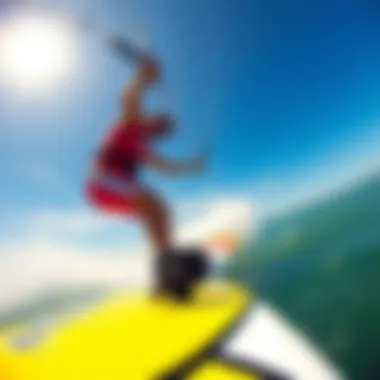
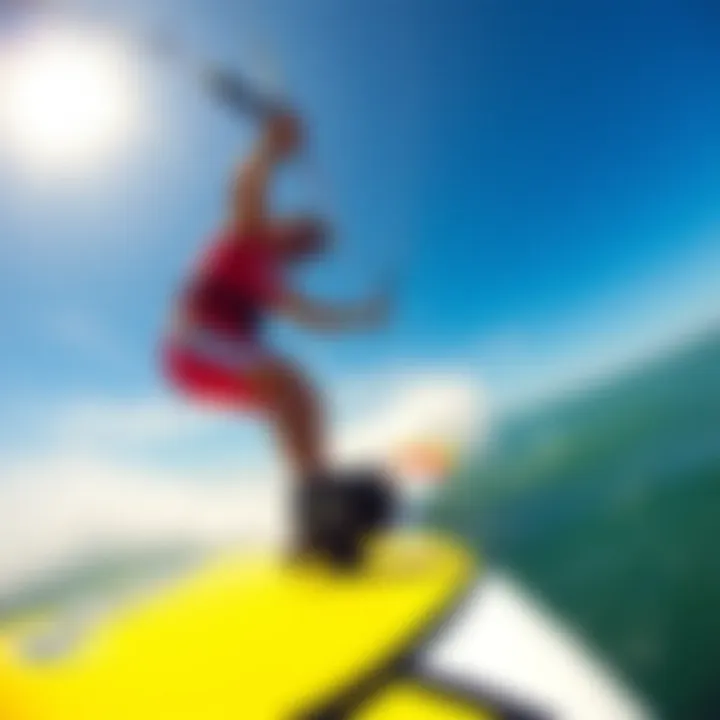
Intro
The exhilarating combination of GoPro technology and kitesurfing offers a unique opportunity to capture unforgettable moments in the air and on the water. As the sun sets on a perfect day, the glimmering waves create a magical backdrop. But to document these epic adventures effectively, enthusiasts need to understand not just their equipment but also the nuances of the sport itself. This guide aims to offer valuable insights on how to marry the two worlds—enhancing kitesurfing experiences while ensuring the footage truly reflects the thrill of the ride.
Gear Selection
Choosing the right gear is crucial for getting the most out of your kitesurfing experience, especially if your goal is to record breathtaking footage with your GoPro.
Types of Kites
When it comes to kites, understanding the various types can make a world of difference. There are primarily two categories:
- C-Kites: Known for their performance and power, these kites excel in freestyle and big air tricks, with a direct line between the rider and the kite. They tend to have a deeper profile, allowing for rapid pop and height during jumps.
- Delta Kites: These kites are great for beginners and intermediate riders. Their larger surface area offers a stable flight, making them easier to control. They excel in low wind conditions and help would-be pros to progressively improve their skills.
Selecting the right kite depends on various factors like personal preference, wind conditions, and skill level. For instance, when serious wind is in play, a C-kite might be the go-to. But on lighter days, a delta kite can keep the fun rolling.
Choosing the Right Board
Pairing the right board with your chosen kite is just as important. Boards come in several shapes and sizes. Consider these aspects:
- Directional Boards: Ideal for riders who enjoy wave riding. These boards allow you to carve through the water gracefully.
- Twintip Boards: Perfect for those who love freestyle maneuvers. They enhance versatility, allowing for easy transitions.
Picking the right board also depends on water conditions. A smaller board is great for flat water, while a larger one can handle choppy surfaces much better.
"Choosing the right gear is about finding harmony between personal style and environmental conditions."
Skill Development
Mastering kitesurfing is not just about gear; it's about honing your skills. Developing techniques can significantly improve performance and the quality of footage you capture.
Essential Techniques
Before the GoPro hits the water, it’s vital to put in some groundwork into the skill set:
- Proper Stance: Maintaining a balanced position while riding is key. This not only allows for better control but also enhances the image quality by minimizing wobble in footage.
- Water Starts: Learn to successfully get up on the board. A smooth water start will make you look more refined on camera and give you confidence to try more maneuvers.
Progression Tips
As with all sports, progression comes with practice and dedication. Here are some practical tips:
- Set Realistic Goals: Aim for one new trick per session. This helps measure progress without overwhelming yourself.
- Watch and Analyze Footage: Use your GoPro to review rides. This can reveal strengths and weaknesses, which is essential for skill development.
- Seek Feedback: Don’t shy away from getting critique from fellow riders or instructors. They might spot things you overlook.
Improving your skills isn’t just about achieving specific tricks; it also shapes the stories you want your footage to tell.
Finale
Kitesurfing with a GoPro opens a window to a world of creativity. The harmony created between top-notch gear and refined techniques tells a story unique to each rider. With a thoughtful approach to gear selection and skill development, anyone can capture the essence of kitesurfing in all its glory. Whether you’re an amateur looking to document weekends at the beach or a seasoned expert pushing limits, understanding these elements is your key to success.
Understanding Kitesurfing
Understanding kitesurfing is the first step to embracing the exhilarating marriage of water and wind. This section seeks to immerse readers in the complexities of kitesurfing, unraveling the sport's intricacies and essentials—crucial knowledge for anyone looking to take to the waves.
Kitesurfing combines elements of surfing, windsurfing, and paragliding, making it a truly unique water sport. It allows individuals to harness the wind's power while gliding over water, providing an unmatched experience of freedom. By dissecting its origins and basics, this guide emphasizes the value of understanding kitesurfing not just from a technical standpoint but also its emotional and social dynamics.
"Kitesurfing is not just a sport, it’s a lifestyle that unites enthusiasts like no other."
The Origins of Kitesurfing
Kitesurfing has a history that, while relatively short compared to other water sports, is rich and fascinating. The sport’s roots can be traced back to the earliest forms of kite flying, used for various purposes across different cultures. In the late 1970s, pioneers like the Eddy brothers in Hawaii began experimenting with the idea of attaching a surfboard to a kite. This was a departure from traditional kite flying and led to the exploration of safety measures and harnesses that are essential for modern kitesurfing. By the late 1980s and early 1990s, the sport surged in popularity, especially in locations with favorable wind conditions, such as Australia, the Caribbean, and Florida. Kitesurfing evolved rapidly, boasting advancements in equipment like the four-line kite and adjustable control bars, which significantly enhanced stability and safety.
Kitesurfing Basics and Terminology
To dive into kitesurfing, it's vital first to familiarize yourself with certain terminology. Understanding the language of kitesurfing makes it simpler to grasp more complex ideas or discussions. Here are a few key terms:
- Kite: The inflatable or non-inflatable sail that catches the wind.
- Board: The platform on which the kitesurfer stands, similar to a surfboard.
- Harness: A device worn by the rider that connects to the kite via lines, redistributing the kite's pull to arms and shoulders.
- Wind Window: The area in which the kite can fly, crucial for mastering various maneuvers.
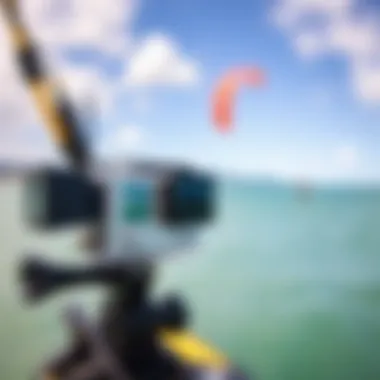
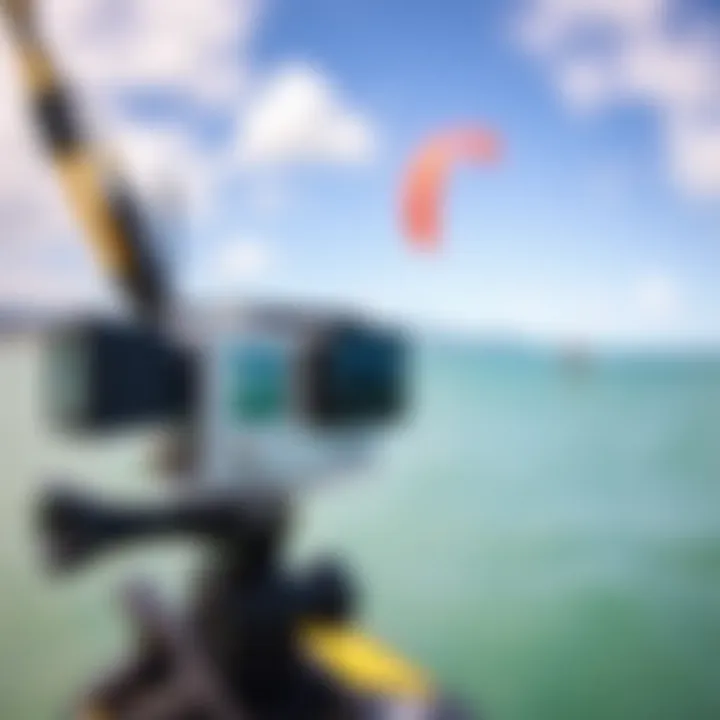
Grasping these terms is essential when getting instruction, whether from an instructor or through online materials.
Essential Gear for Kitesurfing
The right gear can make or break your kitesurfing experience. Here’s a rundown of must-have equipment:
- Kite: Choose one suitable for your skill level and local conditions. For instance, a smaller kite is typically easier to handle for beginners.
- Board: There are different types: twin-tips for versatility and surfboards designed for waves. Your choice should be influenced by your riding style.
- Harness: Consider comfort and convenience. Waist harnesses offer mobility while seat harnesses provide additional support, particularly for newcomers.
- Safety Gear: Helmets and impact vests can prevent injuries. While not required by all riders, safety gear is a smart choice when you're out on the water.
- Control Bar and Lines: These help you steer the kite. Invest in quality items that can withstand the rigors of the sport.
In summary, by understanding kitesurfing, its origins, key terminology, and essential gear, enthusiasts can prepare themselves for an engaging experience. All this knowledge leads to more enjoyable and safer kitesurfing adventures.
The Role of Technology in Kitesurfing
In the realm of kitesurfing, technology isn’t just a supporting actor; it’s the protagonist that drives innovation and enhances the experience for all enthusiasts. From the gear that helps you stay afloat to the cameras that capture your breathtaking adventures, technology plays a pivotal role in elevating this thrilling sport. The integration of various technological advancements not only enhances performance but also encourages safety and reflection on one's progress. Condition changes can be swift on the water, and having reliable tech can mean the difference between a thrilling ride and a potential disaster.
Innovation in Kitesurfing Equipment
Kitesurfing gear has evolved dramatically over the years. The days of heavy, cumbersome kites are behind us, replaced by sleek, lightweight designs crafted from advanced materials. Modern kites often feature innovative designs that allow for increased lift and better stability, allowing riders to harness the wind's power more effectively.
- Improved Materials: Fabrics like ripstop nylon and polyester are common, constructed to minimize tear and enhance durability. This ensures that kites not only perform better but can withstand the tests of time and nature.
- Dynamic Control Systems: The introduction of adjustable lines offers kitesurfers the ability to fine-tune their equipment to match their skill level and environmental conditions. With options to change the kite's angle or the length of its lines, the ride becomes more responsive and tailored.
- Inflatable Designs: Inflatable kites provide excellent safety features. They inflate quickly and remain buoyant on water, making recovering after a fall easier.
Another significant aspect of innovation is the rise of smart gear. Products equipped with sensors can track performance metrics such as speed, height, and airtime. Users can analyze this data to improve their kitesurfing skills effectively. The more informed you are about your riding patterns, the better you can improve your technique.
The Importance of Video Documentation
Video documentation has emerged as a vital tool in the kitesurfing community. Capturing and sharing experiences plays a critical role in personal and communal growth. With portable cameras like GoPro at the forefront, recording sessions has never been simpler or more accessible.
One of the major advantages of filming your kitesurfing endeavors is the ability to review your technique. Examining the footage allows you to spot mistakes that might not be evident while riding.
"Video is a powerful teacher." It helps you refine your skills and understand the movements that lead to better performance.
- Building a Portfolio: For aspiring instructors or competitors, having a well-edited video portfolio can be a game changer. It serves as a means to showcase your prowess and can even lead to sponsorship opportunities.
- Community Engagement: Sharing footage on social media platforms fosters a sense of belonging among kiteboarders. It creates a community of shared experiences where riders can offer constructive critiques or simply celebrate one another’s triumphs.
- Highlighting Safety: Documenting rides also serves to highlight the importance of safety protocols. Riders can review situations that might have been dangerous and help others learn from those experiences, thus elevating overall safety awareness in the sport.
In essence, technology continues to shape the landscape of kitesurfing. As equipment becomes smarter and video documentation more prevalent, the sport is set for continual growth, fostering a community that thrives on innovation and shared experiences.
GoPro Camera Selection
When it comes to capturing the wild thrill of kitesurfing, having the right GoPro camera is more than just a matter of convenience; it’s downright essential. The inherent nature of the sport—rapid movements, splashing waves, and aerial stunts—requires a camera that can keep pace and produce high-quality footage. Choosing a GoPro is about understanding not only the needs of the sport but also how the camera’s features align with those needs.
Choosing the Right GoPro Model
Picking the right GoPro model is like selecting a kite; it must match your skill level and the conditions you plan to tackle. With models ranging from the compact Hero11 Black to the more advanced Hero MAX, each offers unique benefits. If you’re a beginner, the Hero11 Black provides a simple interface alongside excellent footage quality. For those with a touch more experience, exploring the MAX can give you the ability to shoot in 360 degrees, which might be beneficial for capturing those spectacular tricks from all angles.
- Skill Level: Match the camera's complexity to your experience.
- Conditions: Consider how the model performs in adverse weather.
- Editing Needs: If you're into post-production editing, the advanced features of the MAX can yield more versatile footage.
Comparative Features of GoPro Models
Navigating GoPro models involves understanding intricate differences. Each iteration boasts specific attributes that can influence decision-making. Here’s a breakdown of core features that might help in discerning the best fit for your kitesurfing adventures:
- Video Quality: Most GoPro models shoot in 4K, but some may offer higher frame rates for slow-motion playback.
- Image Stabilization: Look for models that include HyperSmooth technology, which combats the bumps and shakes typical in water sports.
- Water Resistance: All GoPro cameras are inherently resistant, yet the depth rating can vary. Ensure your chosen model fits your kitesurfing depths.
- Battery Life: Some models yield longer operational durations, crucial for all-day sessions by the sea.
- Mounting Compatibility: Depending on how you intend to mount the camera—riding on the board or on a helmet—the model’s mounting systems and accessories play a vital role.
Tip: Analyze user reviews and comparative videos. Seeing the camera in action will shed light on how well it performs in real kitesurfing conditions.
Filming Techniques for Kitesurfing
Filming kitesurfing isn't merely about pressing record; it's an art form that can significantly elevate the way you share your adventures. Understanding the nuances of filming techniques in kitesurfing can make the difference between a dull recap and a breathtaking visual storytelling piece. It's essential to capture the exhilarating moments and the rush that comes with each ride. Not only does this enhance your personal collection, but it can also engage a community. When executed correctly, the footage becomes a perfect blend of artistry and sport.
Best Practices for Angle Selection
Choosing the right angle when filming kitesurfing can be a game-changer. It shapes how viewers experience the action and adventure.
- Eye-Level Shots: These create a more immersive view for those watching. It's like they’re right there, feeling the wind.
- Aerial Views: Use a drone or mount your GoPro high to capture the entirety of the scene. This angle emphasizes the vastness of the water and the impressive kite maneuvers. Distinct from typical shots!
- Close-Ups: Focusing on the kitesurfer's expressions and movements adds a layer of intimacy to the footage. Grab those thrilling moments when they land a jump or wipe out.
Experimenting with angles can help you find unique perspectives that make your videos stand out. Don’t hesitate to mix it up, keeping your audience guessing at what they'll see next.
Weather Considerations for Filming
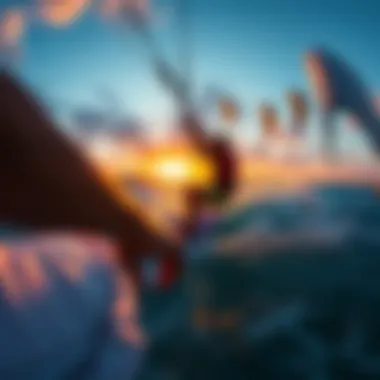
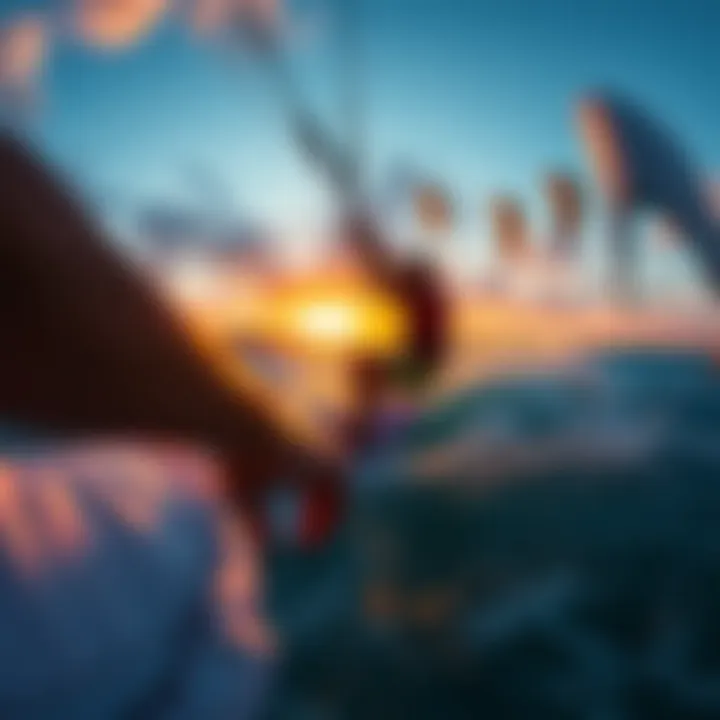
Weather isn't just an afterthought when it comes to filming in kitesurfing. It truly influences the quality of your footage and the entire experience.
- Lighting Conditions: Early mornings or late afternoons provide softer lighting that can reduce harsh shadows. Midday sun may cause overexposure, but if you tackle it right, it can accentuate the colors.
- Wind Conditions: Ensure you’re on a day with optimal wind to achieve the most dynamic shots. Too gusty can lead to chaotic situations both for the athlete and the camera.
- Check Forecasts: It’s wise to use apps or websites like Weather.com or Windy to keep tabs on upcoming forecasts. Reading reports carefully can save you from being caught off guard during a shoot.
Stabilization Techniques with GoPro
Stabilization is crucial when filming fast-paced sports like kitesurfing. Movement is inevitable, and a shaky camera can ruin great footage.
- Use Built-In Stabilization: GoPro cameras have advanced stabilization features like HyperSmooth. This built-in technology can help you achieve buttery smooth shots, even in bumpy conditions.
- **Gimbals:**Consider using a gimbal, especially when you're moving or your subject is jumping high. A gimbal effectively keeps the footage steady regardless of your movements.
- Proper Mounting: Secure your camera firmly to avoid unnecessary jiggles. Ensure that whatever mounting setup you choose is stable and adaptable. Excessive vibrations can distort the video.
By paying attention to how you film, you're not just capturing images; you're creating a narrative that showcases the spirit of kitesurfing. Remember, the goal is to produce engaging content that inspires and resonates with viewers. Through angle selection, weather awareness, and stabilization techniques, you’ll have a toolbox full of methods to enhance your filming experience.
Accessories to Enhance Your GoPro Experience
When it comes to kitesurfing, using a GoPro can dramatically improve the quality of your footage, but that potential can be fully unlocked only with the right accessories. These accessories are not just add-ons; they are essential tools that complement your camera and operations out on the water. From mounting options to protective gear, the right accessories can ensure your GoPro captures every thrilling moment while staying intact throughout the ride.
Mounting Options for Kitesurfing
Choosing the right mounting option for your GoPro can make or break your kitesurfing footage. Kitesurfing generates a lot of action, and how you mount your camera plays a vital role in capturing that dynamism. Here are a few popular options:
- Chest Mounts: These provide an excellent point of view. They capture your hands at work, making the viewer feel part of the action as they watch you steer the kite while riding the waves.
- Helmet Mounts: If safety is your priority, a helmet mount could be the way to go. Securely attached to your helmet, it provides stability and a higher viewpoint. You'll capture an expansive view of the horizon and the kite's movements.
- Wrist Mounts: Ideal for capturing unique angles, wrist mounts offer a different perspective. They’re especially effective for filming your transitions and tricks while spotlighting your board beneath.
- Board Mounts: Placing a GoPro on the board itself opens up a grazing shot of the surf, letting viewers see the waves crashing against your board as you cut through the water. This is especially effective for showing speed.
Selecting a mounting option should reflect the kind of vision you want for your filming.
Protective Gear for Your Camera
Your camera isn’t just a device; it's an investment, and protecting it should be paramount. Kitesurfing subjects your equipment to saltwater, sand, and extreme weather conditions. Here’s what you should consider:
- Dive Housing: If you plan to take the plunge or expect splashes, a dive housing can be invaluable. It keeps the camera dry and protected from moisture.
- Screen Protectors: Scratches and damage can happen during a rough ride. Applying a screen protector can extend the life of the camera screen, ensuring that all footage remains crystal clear.
- Floaty Grip: Securing your GoPro with a floaty grip is a lifesaver. If your camera takes an unplanned dive into the water, this accessory ensures it floats to the surface instead of sinking into the depths.
- Lens Caps: Imagine capturing that once-in-a-lifetime moment only to find out afterwards that your lens was covered in dust or fingerprints. Lens caps safeguard the glass, keeping your shots sharp and clean.
Investing in protective gear can mean the difference between loss and treasured footage. The harsh realities of kitesurfing shouldn't come at the expense of your camera’s longevity.
"Documenting your adventures can be as exhilarating as the rides themselves; don't let gear failure lead to missed memories."
Post-Production Techniques
Post-production is where the magic of kitesurfing footage truly comes alive. It bridges the gap between raw clips and compelling stories that can captivate viewers. Consequently, every kitesurfer, be they a casual weekend warrior or a seasoned pro, should pay attention to this step. The right software and editing techniques can elevate your GoPro footage from simple recordings to striking visual narratives.
Editing allows for multiple creative possibilities, shaping the message you want to convey through your recordings. This will make the end product engaging not just for fellow kiteboarders but also for those outside of the sport. You want viewers to feel the adrenaline rush, the ocean spray, and the thrill of soaring high above the waves. There’s art in assembling clips, in understanding pacing, and how visuals connect emotionally.
Aside from the creative side, mastering post-production can enhance your technical skills. Understanding how to manipulate footage helps in improving your shooting technique, ensuring that the next round of recording is more precise and impactful. Remember, the end result aims to inspire and reflect a deeper understanding of kitesurfing, so attention to detail isn't just important; it's essential.
Editing Software Recommendations
Finding the right editing software is akin to selecting the appropriate gear before hitting the water. You can't expect to catch the perfect wave with subpar equipment, right? Here’s a list of software tools that cater to different skill levels and budgets:
- Adobe Premiere Pro: A powerhouse for professionals, offering advanced features like multi-cam editing and robust color correction tools.
- Final Cut Pro: Ideal for Mac users, this software integrates well with other Apple applications, featuring a magnetic timeline for efficient editing.
- DaVinci Resolve: Free to start, this software provides professional-grade features ranging from editing to color grading.
- iMovie: A beginner-friendly option for Mac users where simplicity reigns. A good way to dip your toes into editing without feeling overwhelmed.
- GoPro Quik: Specifically designed for GoPro footage, it auto-edits videos based on your selected theme, allowing quick sharing without the fuss.
Crafting Compelling Narratives with Footage
When stitching together kitesurfing footage, think about the journey you are taking your viewers on. Instead of a random assortment of clips, strive to build a narrative. A cohesive story works wonders even in action sports. This can be achieved through a few key ideas:
- Start with a Hook: Begin your edit with a breathtaking moment—perhaps a high-flying trick or a stunning sunset as a backdrop. It’s the eye-catcher that can pull people in.
- Build a Structure: Introduce your setting, showcase the action, and never shy from portraying emotions—whether it’s the pure exhilaration of jumping a wave or the peacefulness of gliding over water. Following a classic storytelling arc can help in leading the audience through the experience.
- Use Cutaways Wisely: Don’t just focus on the main action; shots of the surroundings, gear preparation, and even close-ups of expressions can enrich the story.
Encouraging the audience to invest their hearts and minds in your adventure is key. As they watch, they should feel the waves of the ocean, sense the wind that lifts you, and nearly hear the surf crashing at your feet.
Incorporating Music and Effects
Music and sound effects can drastically change the emotional tone of your video, and knowing how to integrate them effectively can enhance the viewing experience. Selecting the right soundtrack is crucial; it should complement, not overpower, the visuals. Here’s how to do it right:
- Match the Mood: Select tracks that resonate with the energy of your footage. An upbeat track for high-energy jumps versus a calm melody for serene rides at sunset.
- Create Tension with Sound Design: Sometimes, silence can be more powerful. Use ambient sounds—like the roar of the ocean or the rustle of the wind—to create atmosphere.
- Pace Your Edits with Music: Align your cuts with the beat of your chosen track. It creates a rhythm that pulls the viewer along, enhancing the overall flow of the narrative.
Incorporating these elements with a thoughtful eye can shift your video from just another kitesurfing clip to a story that resonates with your audience long after the screen goes dark.
Sharing Your Kitesurfing Content
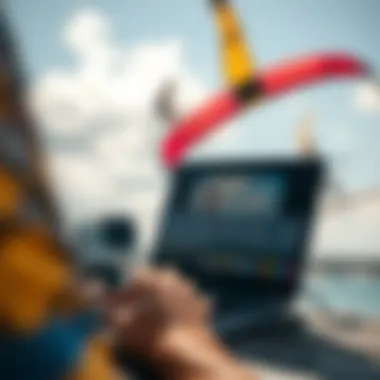
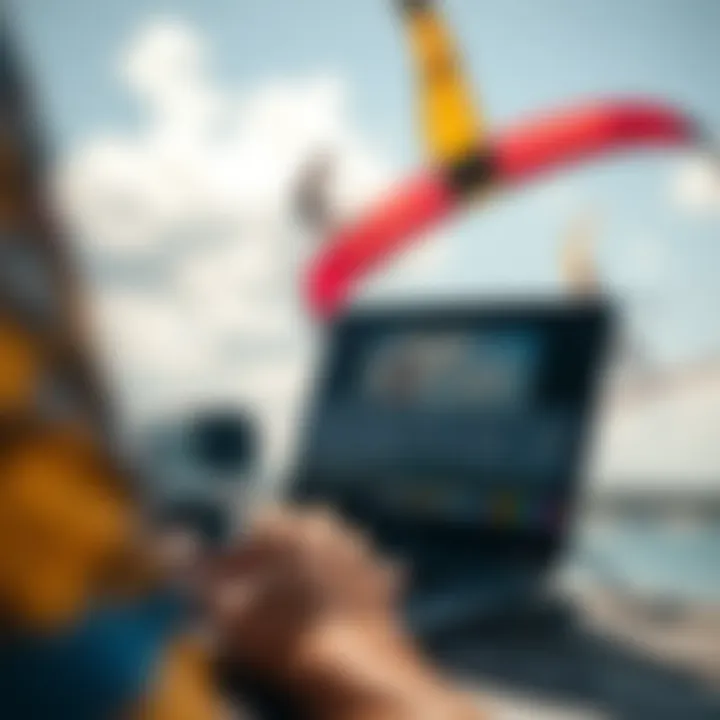
Kitesurfing is not just about personal enjoyment; it's also about sharing those thrilling moments with the world. The act of sharing your kitesurfing content can elevate your experiences and contribute to the wider community of kitesurfers. By documenting and distributing your adventures, you provide inspiration and connect with fellow enthusiasts. Not just any clip will do; knowing how and where to share is crucial.
A well-shared video or photo can act as a beacon, drawing others into the sport. It can also serve as a platform for feedback, allowing you to improve and connect. This is particularly meaningful because kitesurfing often relies on community support and shared experiences. When you put your content out there, you not only showcase your skills but also encourage others to take to the water.
Choosing the Right Platforms
Different platforms cater to different audiences, and picking the right one is half the battle. Here’s a brief outline of some popular avenues for sharing your kitesurfing content:
- YouTube: Great for longer, edited videos. The storytelling aspect shines here, attracting viewers looking for quality content.
- Instagram: Perfect for quick snapshots and short clips. Use engaging stories to keep your audience updated.
- Facebook: A community-centric platform. Good for joining kitesurfing groups and sharing your personal experiences with a targeted audience.
- TikTok: If you have a knack for creating fun, engaging short videos, TikTok could be your playground. Trends change rapidly, but capturing the essence of kitesurfing in a fun manner can garner attention.
While these platforms serve distinct purposes, leveraging them together can maximize your reach. Utilize each platform's unique features—short clips for TikTok, longer features for YouTube—to create a comprehensive picture of your kitesurfing adventures.
Engaging with the Kitesurfing Community
Once you start sharing your content, engaging with the kitesurfing community becomes essential. Active participation can lead to new friendships and even collaborations. Here are avenues for meaningful engagement:
- Comment on Other Videos: When you take time to appreciate others' content by commenting, it builds rapport.
- Join Forums and Groups: Platforms like Reddit have dedicated kitesurfing threads where you can exchange tips and experiences.
- Attend Local Events: Meeting fellow kitesurfers face-to-face can help solidify relationships that began online.
- Collaborate: Partnering with established kitesurfers or influencers can expand your audience and introduce you to different styles of filming or riding.
With every interaction, be authentic. The kitesurfing community thrives on genuine connections, and your contributions can resonate deeply with others. Sharing content is not merely posting; it's an opportunity to cultivate connections, inspire others, and showcase the beauty of the sport. Always remember, the essence of kitesurfing lies in camaraderie, and sharing your experiences can significantly enhance this aspect.
Ethical Considerations and Safety Protocols
In the world of kitesurfing, the thrill of riding the wind and surf can often overshadow the essential responsibilities that come with it. Addressing ethical considerations and safety protocols is not only a matter of personal well-being but also a way to protect the environment and ensure that the sport continues to thrive for future generations. This section delves into the critical nature of these elements, emphasizing collective responsibility among kiteboarders, instructors, and enthusiasts alike.
Respecting the Environment
Kitesurfing is undeniably linked to nature, relying on specific wind patterns and water conditions. As such, practitioners must foster a strong sense of stewardship towards our shared playground. Here are some major considerations:
- Avoid disturbing wildlife: Kitesurfers should be mindful of local ecosystems, staying clear of protected areas where flora and fauna may be vulnerable. For example, if you notice birds nesting on a nearby dune, giving them space is crucial.
- Leave no trace: It's vital to take all your equipment and trash with you after each session. Many spots can be severely affected by litter, so having a trash bag handy is always a good practice.
"We do not inherit the earth from our ancestors; we borrow it from our children." — Native American Proverb
- Choose environmentally friendly products: Wherever possible, opt for sustainable gear and equipment. Some companies manufacture kites and boards from recycled materials or use sustainable practices in production.
By adhering to these principles, kitesurfers can ensure that they are not just enjoying the beauty of the environment but actively contributing to its preservation.
Safety Tips for Filming and Riding
Safety should never be an afterthought, especially when filming dynamic activities like kitesurfing. The combination of wind, water, and the presence of cameras can lead to unforeseen challenges. Here are essential safety tips for kitesurfers:
- Know your limits: Always assess your skill level before heading out. If conditions look too rough, it’s wise to sit this one out.
- Wear appropriate safety gear: A helmet, impact vest, and a leash should be standard for all riders. These can help prevent injuries, especially when filming, where distractions can easily lead to accidents.
- Keep a buddy system: Especially for those who are filming, having a friend nearby not only makes the experience more enjoyable but also offers an additional layer of safety. They can assist if you get into trouble.
- Be aware of your surroundings: While focusing on capturing that perfect shot, don’t forget to keep an eye on other riders, obstacles, and changing weather conditions.
- Practice with your GoPro: Before you hit the waves, get familiar with your GoPro's settings and features so you can focus on the ride rather than fiddling with the camera.
Navigating the twin waters of safety and environmental ethics is essential for maintaining the integrity of kitesurfing. By embracing these practices, the community not only enhances its image but also ensures that the elements remain enjoyable for all.
The Future of Kitesurfing and Media
The landscape of kitesurfing is on the verge of a revolution, driven by advancements in technology, particularly in media and documentation. This section aims to explore how the intertwining of kitesurfing and media will reshape the sport and the community surrounding it. As the sport evolves, the means by which it is documented and shared grows increasingly sophisticated, offering both opportunities and challenges.
One noteworthy consideration is the integration of high-definition video and live streaming, which allows a broader audience to share in the thrill of kitesurfing events, even from their living rooms. This enhances the sport's visibility, attracting new enthusiasts while also serving to promote events and the athletes themselves. As more people tune in to watch live-streamed competitions, sponsors and brands begin to take notice, leading to potential financial support and increased professional opportunities for kitesurfers.
Changes in social media platforms also play a critical role. The ability to share experiences instantly has transformed how kitesurfers connect. Widespread access to platforms like Instagram and TikTok means that an amateur's session can quickly gain traction. This virality not only elevates personal brands but also sets up a cycle of inspiration among the community.
Emerging Trends in Kitesurfing Documentation
The growth of virtual reality (VR) and augmented reality (AR) technology presents exciting possibilities for kitesurfing documentation. Imagine experiencing a kitesurfing session through a VR headset, where users can virtually feel the wind and the waves as if they were actually there. This immersive experience could revolutionize training sessions, allowing athletes to analyze their performance in a realistic setting. It could also enhance the viewer experience for those who cannot physically attend events.
Moreover, the evolution of drone technology is changing how we capture aerial shots. Drones can provide unique perspectives that were once only possible through costly helicopter flights. This not only benefits promotional content but also training videos, where kitesurfers can receive feedback on their techniques from every conceivable angle.
- 360-degree cameras are increasingly becoming popular among kitesurfers. They offer an entirely new way to capture the sport, allowing viewers to shift perspectives while watching a video, creating a more engaging experience.
- User-generated content also continues to rise. More kitesurfers are documenting their own journeys through personal blogs and video channels, contributing to a growing body of content that documents everything from freestyle tricks to adventure trips.
Impact of Social Media on the Sport
Social media acts as both a blessing and a curse within the kitesurfing world. On one hand, it helps to build communities. Kitesurfing enthusiasts can share tips, tricks, and footage of their breathtaking moments on the water. On the other hand, it pushes athletes to constantly perform and document their lives online, which can generate pressure.
The ability to tag brands and attract sponsorships through impressive social content is a double-edged sword. While some kitesurfers have leveraged social media for lucrative deals and collaborations, others may feel the weight of expectation to consistently produce high-quality content, which isn’t always feasible.
Key Considerations:
- Community Building: Social media fosters connections among like-minded individuals, encouraging participation in events and discussions.
- Marketing Opportunities: Brands that align with kitesurfers benefit from authentic content that captures the spirit of the sport.
- Mental Health: As sharing becomes synonymous with participation, maintaining a healthy balance between online and real-life experiences becomes essential.
As kitesurfing and media continue to merge, it's crucial to keep perspective. Embracing technology while respecting the roots and ethos of the sport will ensure that both kitesurfers and enthusiasts can enjoy its future benefits without losing sight of the sheer joy of riding the wind and waves.















